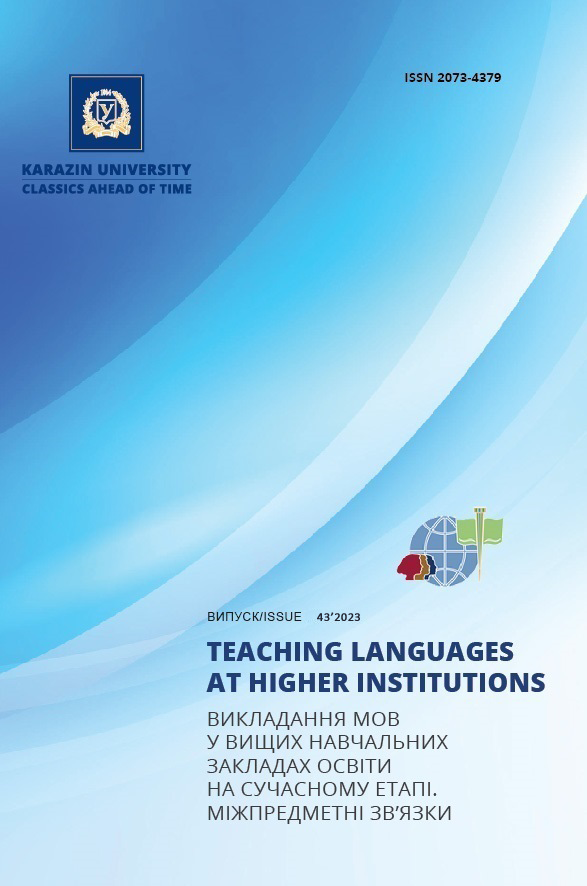Training of engineers on a bilingual basis: specifics of the English mathematical language
Abstract
Due to globalization processes in higher education, the use of English as the medium of instruction is becoming more widespread in non-English-speaking countries. Bilingual education is actively being implemented in Ukraine, where professional disciplines are taught in a foreign language, primarily English. This article emphasizes that in bilingual education, the foreign language serves not only as a goal but also as a means of comprehending specialized knowledge. Consequently, the issues related to the nuances of employing a foreign language within specific subject areas, especially when teaching professional disciplines at technical universities, are highly relevant.
The article underscores that, at present, only specific aspects of the challenges associated with bilingual higher education have been identified. A comprehensive concept of bilingual professional education in Ukraine has yet to be fully developed. In particular, the methodological and technological foundations for bilingual education in professional engineering and technical disciplines remain underdeveloped.
The primary objective of this work is to explore the distinctive features of the English mathematical language within the context of bilingual training for future engineers. The article also analyzes the use of mathematical symbols in acquiring relevant linguistic conventions. It highlights various linguistic aspects of mathematical English texts and conducts a comparative analysis between mathematical and general literary language, examining their shared characteristics and differences.
From this perspective, the article delves into the semantic and syntactic aspects of mathematical language, its vocabulary, terminology, and the role of symbols in mathematical expressions. Particular attention is devoted to the use of variables in standard expressions. Various types of variables are identified, including terms, characteristics, and references.
The article introduces the concept of “highlighting a form in mathematical language and filling this form with variables”, essentially associating structure with content. The practical application of this concept results in the creation of mathematical templates or clichés, which are utilized in bilingual mathematics education. The article provides examples of such templates and illustrates how they can be employed.
Practical experience confirms the effectiveness of this approach, especially when teaching higher mathematics in English to students pursuing engineering and technical specialties. It demonstrates that students can quickly grasp the fundamentals of the English mathematical language through this method
Downloads
References
Ivanenko, S.V. (2019). Bilingual teaching as a mean of mastering special knowledge of the students of nonlinguistic specialties. Pedagogy of creative personality formation in higher and general academic schools, 67, Vol. 1, pp. 39–43. DOI: https://doi.org/10.32840/1992-5786.2019.67-1.8 [in Ukrainian].
Kovalchuk, A.O. (2010). Iz dosvidu vykladannia bilinhvalnykh dystsyplin maibutnim mahistram u provintsiinomu VNZ [From the experience of teaching bilingual disciplines to future masters in a provincial university]. Teaching Languages at Higher Educational Establishments at the Present Stage. Intersubject Relations, 16, pp. 108–114 [in Ukrainian].
Sytniakivska, S.M., Khlyvniuk, M.H. (2014). Features of Implementation the Bilingual Education in the Technical Educational Institutions of Ukraine. Bulletin of Zhytomyr Ivan Franko State University, 6 (78), pp. 167–172 [in Ukrainian].
Snizhko, N.V. (2022). On some aspects of bilingual education in the technical higher school in the context of european integration. Scientific journal of National Pedagogical Drahomanov University. Series 5. Pedagogical Sciences: Realities and Perspectives, Special Issue, Vol. 2, pp. 125–129. DOI: https://doi.org/10.31392/NPU-nc.series5.2022.spec.2.24 [in Ukrainian].
Snizhko, N.V., Rudnievа, V.M. (2021). On the problems of teaching higher mathematics in a foreign language. Interaction of society and science: problems and prospects. Abstracts of ІІІ International Scientific and Practical Conference. London, England, pp. 363–369. DOI: https://doi.org/10.46299/ISG.2021.II.III [in Ukrainian].
Sosinskii, A.B. (2020). Mathematical English. Moscow: MCCME [in Russian].
Stoljar, A.A. (1986). Pedagogy of mathematics. Minsk: Vyshejshaya shkola [in Russian].
Shevchenko, M.V. (2015). Peculiarities of teaching students of technical specialties listening and speaking English. Young Scientist, 2 (17), pp. 329–332 [in Ukrainian].
Chang, Y.-Y. (2012). The use of questions by professors in lectures given in English: Influences of disciplinary cultures. English for Specific Purposes, 31, pp. 103–116. DOI: https://doi.org/10.1016/j.esp.2011.08.002.
DeCarrico, J.S., Nattinger, J.R. (1988). Lexical phrases for the comprehension of academic lectures. English for Specific Purposes, 7 (2), pp. 91–102.
Dudley-Evans, T. (1994). Variations in the discourse patterns favoured by different disciplines and the pedagogical implications. J. Flowerdew (Ed.). Academic listening. Cambridge, England: Cambridge University Press, pp. 146–158.
Hyland, K., Bondi, M. (2006). Academic discourse across disciplines. Frankfurt: Peter Lang AG.
Morell, T. (2004). Interactive lecture discourse for university EFL students. English for Specific Purposes, 23(3), pp. 325–338. DOI: https://doi.org/10.1016/S0889-4906(03)00029-2.
Snizhko, N.V., Rudnievа, V.M. (2022). Features of teaching higher mathematics to students who are doing the course in a foreign language. Pedagogical sciences: theory and practice, 1 (41), pp. 297–303. DOI: https://doi.org/10.26661/2786-5622-2022-1-45.

